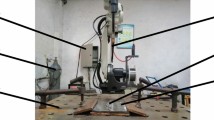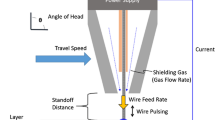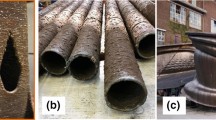Abstract
This paper investigates the feasibility of producing hard structures capable of wear resistance by depositing a hardfacing flux-cored wire while using arc directed energy deposition (DED-Arc) as process. The present paper discloses the compatibility of a metal hardfacing flux-cored wire with this technology by deposition of single walls and block fabrication. The deposition of walls and blocks was made using different parameters and deposition strategies, in order to avoid solidification cracking associated with the precipitation of chromium carbides. Macro and microstructural analyses, as well as hardness tests, were carried out to validate the use of this wire with DED-Arc. The use of a grinder for slag removal was also investigated. Withal, the deposition of a 40-layer wall and blocks indicated that a hardfacing flux-cored wire can be used to produce a near net shape part by additive manufacturing. Additionally, gradient properties of additively manufactured metal parts can be achieved by depositing layers of materials with different characteristics and, with DED-Arc, this can be done through the use of different types of metal wire. Thus, studies on the possibility of constructing a bi-metallic part, by DED-Arc, using a low carbon steel (ER70S-6) and the same hardfacing-cored wire were developed, focusing on crack minimization procedures, such as the application of pre-heating. Assessment of metallurgical transformations and mechanical properties were investigated to assure that the material properties were kept. A final multi-metal part was produced with DED-Arc.














Similar content being viewed by others
Data availability
Not applicable.
Code availability
Not applicable.
References
Williams SW, Martina F, Addison AC, Ding J, Pardal G, Colegrove P (2016) Wire arc additive manufacturing. Mater Sci Technol 32(7):641–647
ISO/ASTM52900-15 (2015) Standard terminology for additive manufacturing—general principles—terminology, ASTM International, West Conshohocken. www.astm.org
Martina F, Ding J, Williams S, Caballero A, Pardal G, Quintino L (2019) Tandem metal inert gas process for high productivity wire arc additive manufacturing in stainless steel. Addit Manuf 25:545–550
Tabernero I, Paskual A, Álvarez P, Suárez A (2018) Study on arc welding processes for high deposition rate additive manufacturing. Procedia CIRP 68:358–362
Colegrove PA, Donoghue J, Martina F, Gu J, Prangnell P, Hönnige J (2017) Application of bulk deformation methods for microstructural and material property improvement and residual stress and distortion control in additively manufactured components. Scr Mater 135:111–118
Silva RJ, Barbosa GF, Carvalho J (2015) Additive manufacturing of metal parts by welding. IFAC-PapersOnLine 48:2318–2322
Geng H, Li J, Xiong J, Lin X, Zhang F (2017) Geometric limitation and tensile properties of wire and arc additive manufacturing 5A06 aluminum alloy parts. J Mater Eng Perform 26(2):621–629
Wang J et al (2018) Characterization of wire arc additively manufactured titanium aluminide functionally graded material: Microstructure, mechanical properties and oxidation behaviour. Mater Sci Eng A 734:110–119
Rodrigues TA, Duarte V, Miranda RM, Santos TG, Oliveira JP (2019) Current status and perspectives on wire and arc additive manufacturing (WAAM). Materials (Basel) 12(7):1121
Wu B et al (2018) A review of the wire arc additive manufacturing of metals: properties, defects and quality improvement. J Manuf Process 35:127–159
Castro e Silva MI (2018) Study of deposition strategies of a wire + arc additive manufactured component. 1–78. https://www.google.com/url?sa=t&rct=j&q=&esrc=s&source=web&cd=&ved=2ahUKEwi73ryEmL3zAhUh4YUKHVPACDcQFnoECAwQAQ&url=https%3A%2F%2Ffenix.tecnico.ulisboa.pt%2FdownloadFile%2F8448200671
Xu X, Ding J, Ganguly S, Diao C, Williams S (2018) Preliminary investigation of building strategies of maraging steel bulk material using wire + arc additive manufacture. J Mater Eng Perform. https://doi.org/10.1007/s11665-018-3521-5
Guo J, Zhou Y, Liu C, Wu Q, Chen X, Lu J (2016) Wire arc additive manufacturing of AZ31 magnesium alloy: grain refinement by adjusting pulse frequency. Materials (Basel) 9(10):823
Voestalpine Bohler Welding. Utp af robotic 600
Huttunen-Saarivirta E, Heino V, Vaajoki A, Hakala TJ, Ronkainen H (2019) Wear of additively manufactured tool steel in contact with aluminium alloy. Wear 432–433:202934
Bandyopadhyay A, Heer B (2018) Additive manufacturing of multi-material structures. Mater Sci Eng R Rep 129(April):1–16
Planas I, Santos M (2015) Additive manufacturing of nickel components using CMT process. 90. https://www.semanticscholar.org/paper/Additive-Manufacturing-of-Nickel-components-using-Pinto/3e55418f1d6c2187fdf63025e1fa4cf0dfad7bbd#paper-header
Cunningham CR, Flynn JM, Shokrani A, Dhokia V, Newman ST (2018) Invited review article: strategies and processes for high quality wire arc additive manufacturing. Addit Manuf 22(June):672–686
ESAB GROUP (2019) Lesson 5—welding filler metals for stainless steels [Online]. Available: https://www.esabna.com/euweb/awtc/lesson5_10.htm (Accessed: 27-Sep-2019)
Collier J (2019) Carbide precipitation and welding keyway [Online]. Available: http://www.weldingtipsandtricks.com/carbide-precipitation.html (Accessed: 27-Sep-2019)
Ding D, Pan Z, Cuiuri D, Li H (2015) A multi-bead overlapping model for robotic wire and arc additive manufacturing (WAAM). Robot Comput Integr Manuf 31:101–110
CEN (2014) ISO 5817:2014 welding—fusion-welded joints in steel, nickel, titanium and their alloys (beam welding excluded)—quality levels for imperfections
Haden CV, Zeng G, Carter FM, Ruhl C, Krick BA, Harlow DG (2017) Wire and arc additive manufactured steel: Tensile and wear properties. Addit Manuf 16(2010):115–123
Funding
The authors have no relevant financial or non-financial interests to disclose.
Author information
Authors and Affiliations
Corresponding author
Ethics declarations
Conflict of interest
The authors have no conflicts of interest to declare that are relevant to the content of this article.
Additional information
Publisher's Note
Springer Nature remains neutral with regard to jurisdictional claims in published maps and institutional affiliations.
Rights and permissions
About this article
Cite this article
Cardoso, A., Assunção, E. & Pires, I. Study of a hardfacing flux-cored wire for arc directed energy deposition applications. Int J Adv Manuf Technol 118, 3431–3442 (2022). https://doi.org/10.1007/s00170-021-08144-6
Received:
Accepted:
Published:
Issue Date:
DOI: https://doi.org/10.1007/s00170-021-08144-6




